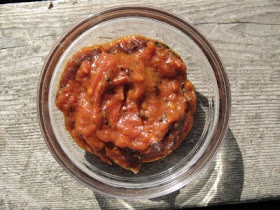
A few years ago, I saw an excellent writer talk about how he was incapable of sitting down to put words to paper. During the question period, someone in the audience asked what he did instead of write. He stopped to think about this. "Well," he said, "I check my email a few hundred times a day. And I have a series of snacks."
That sounds like a pretty apt description of my own life. "Snack" is definitely one of my favorite food categories. Sure, I'm happy to pull together a foursquare meal with vegetables and protein and whole grains and all that. But a tasty cocktail and a frightening amount of bread and cheese? Who is to say that's not a meal?
Last week, I ended up pulling together an impromptu dinner party on short notice. My love of Spanish food combined with my love of snacks made a tapas-inspired dinner a natural choice. One friend brought a baguette and cheese, and we dug up some rhubarb liqueur from the basement. I cracked open a jar of pickled asparagus and topped the scattered stalks with hard-boiled eggs, a trick I recently read in a book. I also sauteed up some mushrooms with garlic and sherry, to go with the baguette. But we still needed something else, and I didn't want to go to the store. Which led me to Potatoes Bravas.
Potatoes Bravas, also called Papas Bravas, is a common Spanish tapas, and basically a clever way to make you feel classy and continental while eating a version of fries and catsup. Fried (or, in this case, roasted) potatoes are topped with spicy brava sauce, and then a garlicky aioli. American that I am, I get somewhat squicked out by topping an oily item with mayonnaise, so I omitted the aioli. The brava sauce is condiment enough. The twice-cooked potatoes turn soft and buttery, and are then perked up by the spicy-sour-smoky brava sauce. The fact that I could make these without leaving the house only added to their charm.

Potatoes Bravas
adapted, heavily, from The Barcelona Cookbook
serves 4 or so, depending on what else is being served
2 lbs waxy potatoes (red or yellow)
1/2 cup olive oil, divided
1 onion, thinly sliced
3 cloves garlic, chopped
1/2 Tbsp pimenton (smoked Spanish paprika)
pinch cayenne (if using sweet pimenton - omit if using spicy)
1/2 tsp cumin
~1 lb chopped tomatoes, fresh or canned
1 Tbsp sherry vinegar
salt
Preheat the oven to 450 degreees.
Prepare the potatoes: Put the potatoes in a pot, and cover with salted water. Bring to a boil, then reduce the heat and simmer until they're tender (about 15 minutes). Remove, and allow to cool slightly. When they're cool enough to handle, cut them in quarters into fat wedges. Toss with 1/4 cup of the olive oil, sprinkle with salt, and place on a baking pan. Roast in the oven, turning once, until crusty and slightly browned (about 10-15 minutes per side).
While the potatoes are cooking, prepare the Brava sauce: Heat the remaining 1/4 cup olive oil over medium heat in a heavy skillet. Saute the onion until translucent and soft but not browned, about 10 minutes. Add the garlic and cook until tender, another 5 minutes. Stir in the pimenton, cumin, and cayenne (if using). Add the tomatoes, and simmer 15 minutes to blend flavors. Stir in the vinegar, then puree mixture in a blender until smooth. Season to taste with salt.
To serve, drizzle the sauce either under or over the cooked potato wedges, in whatever manner seems most aesthetically pleasing. Enjoy, ideally with a glass of wine.

















